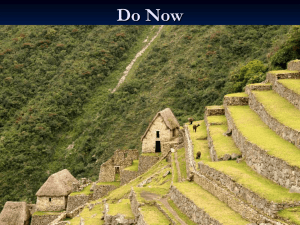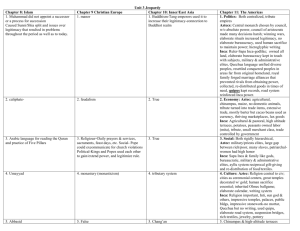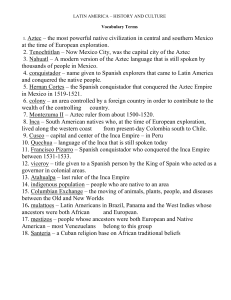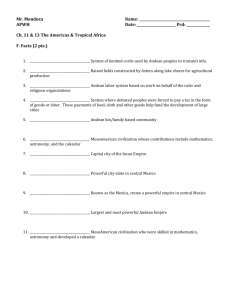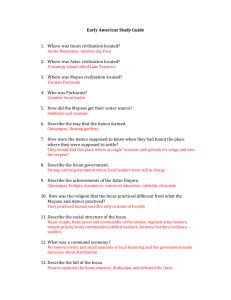AP CHAPTER 11 – STUDY GUIDE
advertisement
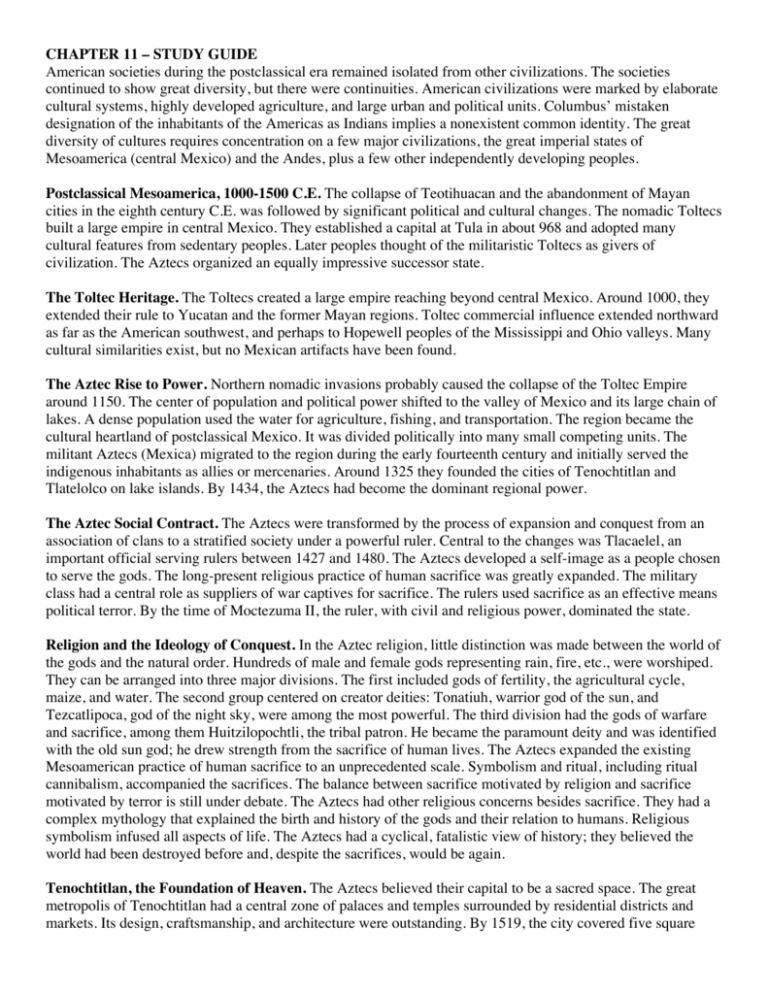
CHAPTER 11 – STUDY GUIDE American societies during the postclassical era remained isolated from other civilizations. The societies continued to show great diversity, but there were continuities. American civilizations were marked by elaborate cultural systems, highly developed agriculture, and large urban and political units. Columbus’ mistaken designation of the inhabitants of the Americas as Indians implies a nonexistent common identity. The great diversity of cultures requires concentration on a few major civilizations, the great imperial states of Mesoamerica (central Mexico) and the Andes, plus a few other independently developing peoples. Postclassical Mesoamerica, 1000-1500 C.E. The collapse of Teotihuacan and the abandonment of Mayan cities in the eighth century C.E. was followed by significant political and cultural changes. The nomadic Toltecs built a large empire in central Mexico. They established a capital at Tula in about 968 and adopted many cultural features from sedentary peoples. Later peoples thought of the militaristic Toltecs as givers of civilization. The Aztecs organized an equally impressive successor state. The Toltec Heritage. The Toltecs created a large empire reaching beyond central Mexico. Around 1000, they extended their rule to Yucatan and the former Mayan regions. Toltec commercial influence extended northward as far as the American southwest, and perhaps to Hopewell peoples of the Mississippi and Ohio valleys. Many cultural similarities exist, but no Mexican artifacts have been found. The Aztec Rise to Power. Northern nomadic invasions probably caused the collapse of the Toltec Empire around 1150. The center of population and political power shifted to the valley of Mexico and its large chain of lakes. A dense population used the water for agriculture, fishing, and transportation. The region became the cultural heartland of postclassical Mexico. It was divided politically into many small competing units. The militant Aztecs (Mexica) migrated to the region during the early fourteenth century and initially served the indigenous inhabitants as allies or mercenaries. Around 1325 they founded the cities of Tenochtitlan and Tlatelolco on lake islands. By 1434, the Aztecs had become the dominant regional power. The Aztec Social Contract. The Aztecs were transformed by the process of expansion and conquest from an association of clans to a stratified society under a powerful ruler. Central to the changes was Tlacaelel, an important official serving rulers between 1427 and 1480. The Aztecs developed a self-image as a people chosen to serve the gods. The long-present religious practice of human sacrifice was greatly expanded. The military class had a central role as suppliers of war captives for sacrifice. The rulers used sacrifice as an effective means political terror. By the time of Moctezuma II, the ruler, with civil and religious power, dominated the state. Religion and the Ideology of Conquest. In the Aztec religion, little distinction was made between the world of the gods and the natural order. Hundreds of male and female gods representing rain, fire, etc., were worshiped. They can be arranged into three major divisions. The first included gods of fertility, the agricultural cycle, maize, and water. The second group centered on creator deities: Tonatiuh, warrior god of the sun, and Tezcatlipoca, god of the night sky, were among the most powerful. The third division had the gods of warfare and sacrifice, among them Huitzilopochtli, the tribal patron. He became the paramount deity and was identified with the old sun god; he drew strength from the sacrifice of human lives. The Aztecs expanded the existing Mesoamerican practice of human sacrifice to an unprecedented scale. Symbolism and ritual, including ritual cannibalism, accompanied the sacrifices. The balance between sacrifice motivated by religion and sacrifice motivated by terror is still under debate. The Aztecs had other religious concerns besides sacrifice. They had a complex mythology that explained the birth and history of the gods and their relation to humans. Religious symbolism infused all aspects of life. The Aztecs had a cyclical, fatalistic view of history; they believed the world had been destroyed before and, despite the sacrifices, would be again. Tenochtitlan, the Foundation of Heaven. The Aztecs believed their capital to be a sacred space. The great metropolis of Tenochtitlan had a central zone of palaces and temples surrounded by residential districts and markets. Its design, craftsmanship, and architecture were outstanding. By 1519, the city covered five square miles and had 150,000 residents. The island city was connected to the lakeshores by four causeways and was crisscrossed by canals. Each city ward was controlled by a kin group (calpulli) who maintained temples and civic buildings. Tribute and support came to the imperial city-state from allies and dependents. Feeding the People: The Economy of the Empire. Feeding the Aztec confederation depended both on traditional agricultural forms and innovations. Conquered peoples lost land and gave food as tribute. In and around the lake, the Aztecs developed a system of irrigated agriculture. They built chinampas, artificial floating islands, that permitted the harvesting of high-yield multiple yearly crops. Aztec peasant production and tribute supplied the basic foods. Clans in each community apportioned land among people, nobles, and temples. There were periodic markets for exchange. The great daily market at Tlatelolco was controlled by a merchant class (pochteca) that specialized in long-distance luxury item trade. The Aztecs had a state-controlled mixed economy: tribute, markets, commodity use, and distribution were highly regulated. Aztec Society in Transition. The society of the expanding Aztec Empire became increasingly hierarchical. Calpulli organization survived, but different social classes appeared. Tribute from subject peoples was not enough to maintain the large Aztec population. Widening Social Gulf. By the sixteenth century, the seven original calpulli had expanded from kinship groups to become residential groupings including neighbors, allies, and dependents. The calpulli performed vital local functions in distributing land and labor and maintaining temples and schools. During wars, they organized military units. Calpulli were governed by councils of family heads, but all families were not equal. During Aztec expansion, a class of nobility (pipiltin) had emerged from privileged families in the most distinguished calpulli. The nobles controlled the military and priesthood. Military virtues infused all society and were linked to the cult of sacrifice; they justified the nobility's predominance. Death in battle ensured eternal life, a reward also going to women dying in childbirth. The social gulf separating nobles from commoners widened. Social distinctions were formalized by giving the pipiltin special clothes and symbols of rank. The imperial family members were the most distinguished of the pipiltin. A new class of workers resembling serfs was created to serve on the nobility's private lands. They held a status above slaves. Other groups, scribes, artisans, and healers, constituted an intermediate social group in the larger cities. Long-distance merchants had their own calpulli, but restrictions blocked their entry into the nobility. Overcoming Technological Constraints. Aztec women had a variety of roles. Peasant women helped in the fields, but their primary work was in the household; skill in weaving was highly esteemed. Elder women trained young girls. Marriages were arranged between lineages, and female virginity was important. Polygamy existed among the nobility; peasants were monogamous. Women inherited and passed on property, but in political and social life they were subordinate to men. Mesoamerican New World technology limited social development, especially for women, when compared with that in other cultures. The absence of milling technology meant that women spent many hours daily in grinding maize by hand for household needs. The total Aztec population may have reached more than 20 million. A Tribute Empire. Each of the Aztec city-states was ruled by a speaker chosen from the nobility. The ruler of Tenochtitlan, the Great Speaker, surpassed all others in wealth and power. He presided over an elaborate court. A prime minister, usually a close relative of the ruler, had tremendous power. There was a governing council, but it lacked real power. During the first 100 years of Aztec expansion, a powerful nobility and emperor had taken over authority formerly held by calpulli. Military virtues became supreme as the state religion, and the desire for more tribute and captives for sacrifice drove the Aztecs to further conquests. The empire was not integrated; defeated local rulers often remained in place as subordinate officials. They were left alone if tribute and labor obligations were met. Revolts against the exactions were ruthlessly suppressed. The Aztec system was successful because it aimed at political domination and not direct control. In the long run, the growing social stresses created by the rise of the pipiltin and the terror and tribute imposed on subjects contributed to the empire's collapse. In Depth: The "Troubling" Civilizations of the Americas. European concepts of civilization did not match with the practices of American Indians. Judging a civilization different from one’s own is always a complex proceeding. While some condemn Aztec sacrifice, others romanticize the Indian past. The arguments about the possible existence of Inca socialism or the nature of Aztec religion are examples. Moral judgment is probably inevitable, but students of history must strive to understand a people’s practices in the context of their own time and culture. Twantinsuyu: World of the Incas. During the period following the disintegration of the states of Tihuanaco and Huari (c.550-1000 C.E.) smaller regional states exercised power in the Andes. Some of them were centers of agricultural activity and population density. The considerable warfare among the states resembled the postToltec period in Mesoamerica. The state of Chimor (900-1465) emerged as most powerful, controlling most of the north coast of Peru. After 1300, the Incas developed a new civilization. The Inca Rise to Power. In the southern Andean highlands, many groups fought for supremacy. Quechuaspeaking clans (ayllus) around Cuzco won control of territory formerly under Huari. By 1438, under Pachacuti, they began campaigns ending with their control of the region. Pachacuti's son, Topac Yupanqui (1471-1493), conquered Chimor and extended Inca rule into Ecuador and Chile. Huayna Capac (1493-1527) consolidated the conquests; by his death, the Inca Empire—Twantinsuyu—stretched from Colombia to Chile, and eastward to Bolivia and Argentina. From 9 to 13 million people were under Inca rule. Conquest and Religion. The Inca had other reasons for expansion besides the desire for economic gain and political power. They adopted from Chimor the practice of "split inheritance": all of a ruler’s political power went to the successor, while all wealth and land passed to male descendants for the eternal support of the cult of the dead ruler's mummy. The system created a justification for endless expansion. Inca political and social life was infused with religious meaning. The sun was the highest deity; the ruler (Inca) was the god’s representative on earth. The Temple of the Sun at Cuzco was the center of state religion. The sun cult spread throughout the empire, but the worship of local gods continued. Popular belief was based on a profound animism that endowed natural phenomena with spiritual power. Prayers and sacrifices were offered at holy shrines (huacas), which were organized into groupings under the authority of ayllus. The temples were served by priests and women dedicated to preparing the sacrifices and managing important festivals and celebrations. The Techniques of Inca Imperial Rule. The Inca, considered virtually a god, ruled the empire from Cuzco. It also was the site of the major temple. The empire was divided into four provinces, each under a governor. The Incas had a bureaucracy in which most of the nobility served. Local rulers (curacas) continued in office in return for loyalty. They were exempt from tribute and received labor or produce from their subjects. Their sons were educated in Cuzco. The Quechua language, the use of colonists (mitmaqs), and the forced transfer of peoples were important techniques for integrating the empire. A complex system of roads, bridges, and causeways, with way stations (tambos) and storehouses, helped military movement. Conquered peoples supplied land and labor. They served in the military and received rewards from new conquests. The Inca state organized building and irrigation projects beyond the capabilities of subject peoples. In return, tribute and loyalty were required. All local resources were taken and redistributed: there were lands for the people, the state, and religion. Labor on state and religious land was demanded rather than tribute in kind. Women had to weave cloth for the court and religious use. Some women were taken as concubines for the Inca or as temple servants. Each community was controlled by the ayllus and aimed at self-sufficiency. Most men were peasants and herders. Women worked in the household, wove cloth, and aided in agriculture. Since Andean people recognized parallel descent, property passed in both lines. Even though an ideology of complementarity of the sexes was strong, the emphasis on military virtue made men dominant. The idea of gender cooperation was reflected in cosmology. Gods and goddesses were venerated by both sexes, though women had a special feeling for the moon and the fertility goddesses of the earth and corn. The ruler's senior wife was a link to the moon. Still, male power within the empire showed in the selection of women for state and temple purposes. The integration of imperial policy with regional diversity was a political achievement. Reciprocity between the state and local community allowed the empire to function efficiently. Within the system, the Inca nobility had many privileges and were distinguished by dress and custom. There was no distinct merchant class because of the emphasis on self-sufficiency and state management of the economy. The state remained strong until it lost control of its subject peoples and government mechanisms. Royal multiple marriages used to forge alliances eventually created rival claimants for power and civil war. Inca Cultural Achievements. The Inca produced beautiful pottery and cloth. Their metallurgy was among the most advanced in the Americas. They lacked the wheel and a writing system, instead using knotted strings (quipu) for accounts and enumeration. The peak of Inca genius was in statecraft and architecture. They constructed great stone buildings, agricultural terraces, irrigation projects, and road systems. Comparing Incas and Aztecs. Both empires were based on the long development of civilizations that preceded them. They excelled in imperial and military organization. The two were based on intensive agriculture organized by the state; goods were redistributed to groups or social classes. The Aztecs and Incas transformed an older kinship system into a hierarchical one in which the nobility predominated. In both, the nobility was the personnel of the state. Although the Incas tried to integrate their empire as a unit, both empires recognized local ethnic groups and political leaders in return for loyalty. The Aztecs and Incas found their military power less effective against nomadic frontier people; their empires were based on conquest and exploitation of sedentary peoples. There were considerable differences between Incas and Aztecs, many of them the result of climate and geography. Trade and markets were more developed among the Aztecs. Other differences were present in metallurgy, writing systems, and social definition and hierarchy. In the context of world civilizations, both can be viewed as variations of similar patterns, with sedentary agriculture as the most important factor. The Other Indians. Mesoamerican and Andean civilizations were high points of Indian cultural development. The rest of the American continents were occupied by many peoples living in different ways. They can be grouped according to gradations based on material culture and social complexity. The Incas shared many things with tribal peoples of the Amazon, including clan divisions. The diversity of ancient America forces a reconsideration of patterns of human development dependent on examples from other civilizations. Social complexity based on agriculture was not necessary for fishing and hunting-gathering societies of the northwest United States and British Columbia: they developed hierarchical societies. In Colorado and South America, Indians practiced irrigated agriculture but did not develop states. How Many Indians? Arguments about the population of the Americas have been going on for a long time. Most scholars now agree that Mesoamerica and the Andes had the largest populations. If we accept a total of 67 million, in a world population of about 500 million, Americans clearly were a major segment of humanity. Differing Cultural Patterns. There were major cultural patterns in the Americas outside of the main civilization areas. They shared features with both the Andes and Mesoamerica, perhaps serving at times as points of cultural and material change between the two regions. In central Colombia, the Muisca and Tairona peoples had large sedentary agriculture–based chiefdoms that shared many resemblances with other similarly based states. Along the Amazon, the rich aquatic environment supported complex populous chiefdoms; other large populations dependent on agriculture were present on Caribbean islands. Such societies resembled societies in Polynesia. By 1500, agriculture was widely diffused throughout the Americas. Some societies combined it with hunting-gathering and fishing. Slash-and-burn farming caused frequent movement in societies often not possessing large numbers, strong class divisions, or craft specialization. There were few nomadic herders. In 1500, about 200 languages were spoken in North America. By then, the towns of the Mississippi Mound Builders had been abandoned and only a few peoples maintained their patterns. In the southwest, the Anasazi and other cliff dwellers had moved to pueblos along the Rio Grande and practiced irrigated agriculture. Most other North American Indians were hunters and gatherers, sometimes also cultivating crops. In rich environments, complex social organization might develop without agriculture. There were sharp differences with contemporary European and Asian societies. Most Indian societies were kin based, with communal ownership of resources. Material wealth was not important for social rank. Women were subordinate to men but in many societies held important political and social roles. They had a central role in crop production. Indians, unlike Europeans and Asians, viewed themselves as part of the ecological system, not in control of it. American Indian Diversity in World Context. Two great imperial systems had been created in Mesoamerica and the Andes. By the close of the fifteenth century, these militaristic states were fragile, weakened by internal strains and technological inferiority. American societies ranged from the Aztec-Inca great civilizations to small bands of hunters. The continued evolution of all Indian societies was disastrously disrupted by European invasions beginning in 1492. Global Connections: The Americas and the World. American isolation from Afro-Eurasia shows in the absence of key technologies like ironworking and the wheel, in the small number of domesticated animals, and in the lack of a great world religion. Most tragically, it shows in the absence of immunity to contagious diseases from the Old World. However, there were impressive economic, cultural, and political achievements. HOMEWORK FOR CHAPTER 11 Teotihuacan chinampas Toltec culture Aztecs Mesoamerica Tribute system Chaco Canyon chiefdom Chavin khipus (quipu) Mississipian culture (mound builders) ayllu Moche Tiwanaku Wari Inca Quetzalcoatl Lake Texcoco Tenochitlan Huitzilopochtli calpulli Cuzco split inheritance Temple of the Sun Olmec culture Mixtec culture Zapotec culture Mayan culture pre-Columbian Quecha language Homework for Chapter 11 Vocabulary Cards Instructions for how to complete vocabulary cards are on the website. You will be graded for these cars on the day of the test. You will be expected to complete all of the cards but will be graded on whichever cards I choose the day they are due, so make sure you have all of the cards complete. Collaborize Classroom: There will be a collaborize classroom assignment that is due by Sunday night. Please make sure you get in early and post your comments, because they close Sunday at 11:45pm and will not let you post after that. Review PPTs: Review the PPTs and complete a summary or the accompanying worksheet Additional Reading: Check the calendar and the website for any additional reading. Answer the attached questions or annotate the reading. Reading and Notes: Read Chapter 11 from the Stearns book, pages 234-255. Take Cornell Notes on the chapter. These will be due on the day of the Chapter Test. Due Nov. 27-A, Nov. 28-B. Directions on how to write your Cornell Notes are on the class website. Suggested Reading Homework schedule: Nov. 20-21 Read Ch.11 - ONLY read headings and picture captions Nov. 23- Read Ch.11 - ONLY read first sentence of each paragraph Nov. 24- Read Ch.11 - Read entire chapter, write a 1 sentence summary on your cornell notes for each section, write your 7 questions - one for each PIRATES theme. If you follow this format you will have reviewed the chapter at least 3 times. This will help you on your quiz. Don’t forget quiz grades cannot be improved, only chapter tests can be retaken. THE CHAPTER TEST IS ON NOV.27-A, NOV.28-B. WHEN YOU COME TO CLASS ON EITHER NOV 2728. YOU WILL TURN IN YOUR CORNELL NOTES AND VOCABULARY CARDS FOR THE CHAPTER. YOUR QUIZ FOR CHAPTER 11 IS A TAKE HOME QUIZ OVER THE THANKSGIVING WEEKEND. DON’T FORGET TO COMPLETE IT.


